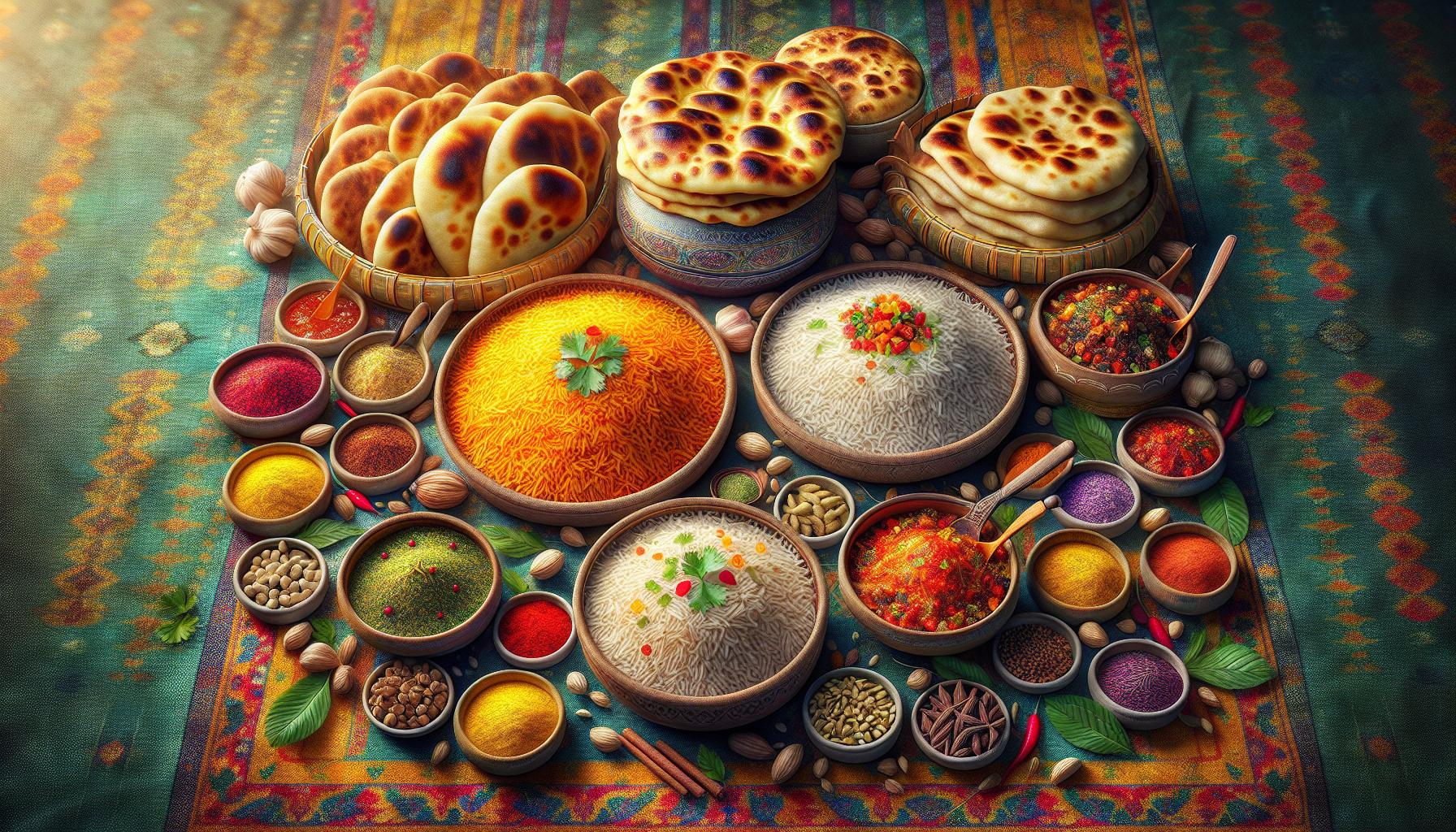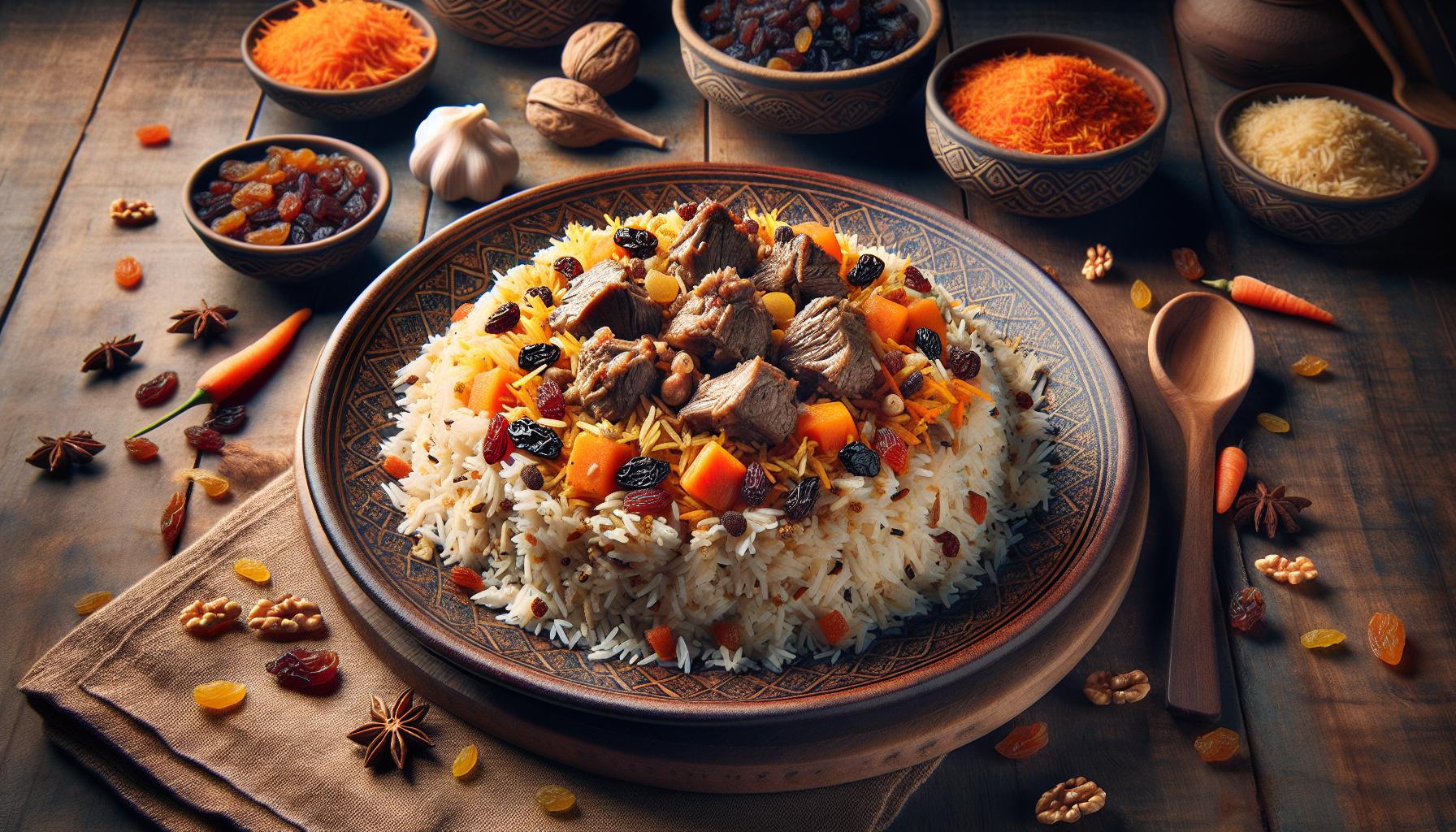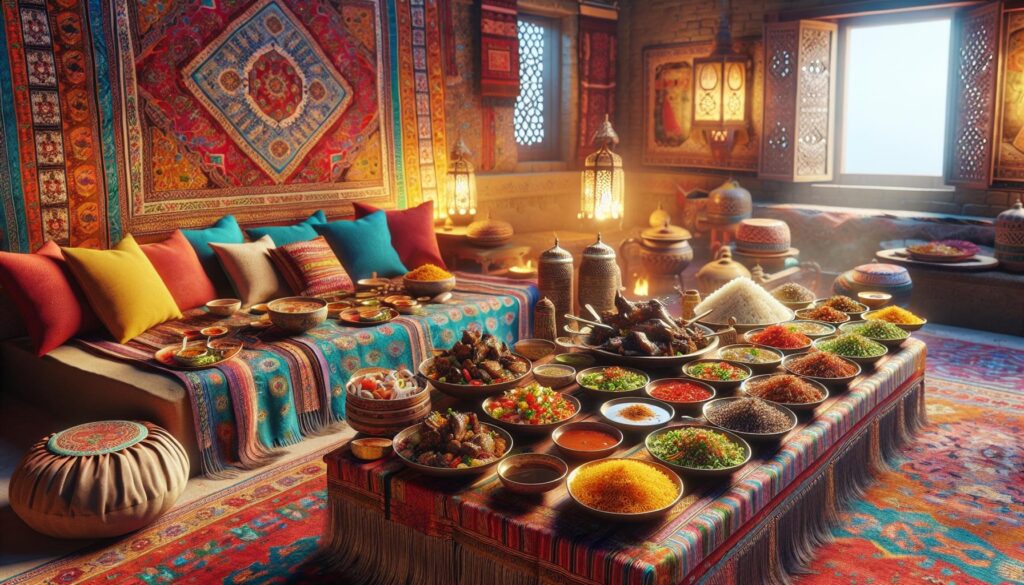Afghan cuisine tells a vibrant story of flavors shaped by centuries of trade along the ancient Silk Road. From aromatic rice dishes to hearty stews and fresh-baked flatbreads, Afghanistan’s food culture reflects its rich history as a crossroads of civilizations between Central and South Asia.
The heart of Afghan dining lies in its communal nature where families and friends gather around the dastarkhan – a traditional cloth spread on the floor for meals. Every dish carries deep cultural significance with recipes passed down through generations. Whether it’s the national dish Kabuli Pulao or the street-favorite Bolani, Afghan cuisine masterfully blends Persian, Indian and Central Asian influences to create unique flavors that dance on the taste buds.
Afghanistan Food Culture
Afghan cuisine embodies the essence of centuries-old traditions passed down through generations. The culinary heritage reflects a complex tapestry of flavors shaped by trade routes geographic diversity cultural exchanges.
Historical Influences on Afghan Food
Afghanistan’s strategic location along the ancient Silk Road created a fusion of culinary traditions from multiple civilizations. Persian influences brought saffron rice dishes dried fruits nuts while Mongol traders introduced dumplings meat-based recipes. The Mughal Empire contributed rich curry preparations aromatic spices such as cardamom cinnamon turmeric. Central Asian nomads integrated yogurt-based dishes grilled meats into Afghan cooking traditions. Greek influences from Alexander the Great’s conquests added unique preparation methods cooking techniques that persist in modern Afghan cuisine.
Regional Diversity in Cooking Styles
Each Afghan region maintains distinct cooking methods ingredients based on local climate resources. Northern provinces feature Uzbek-influenced dishes like Qabuli Palaw tandoor-baked breads. Southern regions incorporate spicier preparations with greater Indian influences evident in curry dishes chutneys. Eastern provinces bordering Pakistan specialize in grilled meats kebabs chapli kebab. Western Afghanistan shares culinary elements with Iran emphasizing saffron-based rice dishes stews. Mountain communities rely on preserved foods dairy products including qurut dried yogurt balls. Urban centers like Kabul blend traditional regional styles with contemporary cooking methods creating innovative interpretations of classic dishes.
Traditional Afghan Cooking Methods

Traditional Afghan cooking methods emphasize slow preparation techniques paired with distinct spice combinations to create deep flavors. These time-honored practices reflect centuries of culinary expertise passed through generations.
The Art of Slow Cooking
Afghan cuisine centers on the practice of dam pukht, a slow-cooking method that creates tender meats and aromatic rice dishes. Meats simmer for 4-6 hours in sealed pots with spices like cardamom, coriander seeds, cumin, and saffron until they reach peak tenderness. Traditional dishes such as korma, qorma, and yakhni utilize this method to develop complex flavor profiles. Vegetables cook separately then combine with the meat during the final stages, preserving their texture while absorbing the rich broth.
Use of Traditional Clay Ovens
The tandoor, a cylindrical clay oven, serves as a cornerstone of Afghan cooking traditions. These ovens reach temperatures of 900°F (482°C) creating distinct smoky flavors in breads, meats, and vegetables. Naan bread sticks to the tandoor walls, developing characteristic blisters and char marks in 2-3 minutes. Marinated meats like tandoori chicken, kebab, and tikka cook on long metal skewers suspended vertically in the oven. The intense heat seals in moisture while creating a crispy exterior crust on foods.
Essential Ingredients in Afghan Cuisine

Afghan cuisine relies on a core set of ingredients that form the foundation of its traditional dishes, reflecting the country’s agricultural heritage and cultural influences from neighboring regions.
Rice and Bread Varieties
Long-grain Basmati rice serves as the cornerstone of Afghan cuisine, particularly in signature dishes like Kabuli Pulao. Afghan cooks prepare rice through a multi-step process, washing it thoroughly and soaking it before cooking to achieve distinct, separate grains. Naan, a flatbread made from wheat flour, comes in several regional variations including roghani naan (enriched with oil) and lavash (thin, crispy sheets). Local bakers produce these breads daily in tandoor ovens, creating the characteristic bubbled crust and smoky flavor. Traditional Afghan households incorporate multiple types of rice and bread, including challaw (plain white rice) and obi non (water bread).
Spices and Seasonings
Afghan cooking incorporates diverse spices that create complex flavor profiles in traditional dishes. Cardamom, cumin, coriander seeds, black pepper, turmeric form the basic spice foundation. Saffron, harvested in the Herat region, adds color and aroma to special dishes and festive meals. Fresh mint, cilantro leaves enhance both cooked dishes and garnishes. Dried herbs like basil, thyme contribute earthy notes to slow-cooked stews. Afghan cooks combine garlic, ginger root to create aromatic bases for meat dishes. Traditional seasoning blends incorporate ground dried rose petals, black cardamom pods giving Afghan cuisine its distinctive taste.
Popular Afghan Dishes and Delicacies

Afghan cuisine features distinctive dishes characterized by aromatic spices, tender meats, and fluffy rice preparations. Traditional recipes showcase the nation’s culinary heritage through carefully selected ingredients and time-honored cooking techniques.
Kabuli Pulao: The National Dish
Kabuli Pulao stands as Afghanistan’s national dish, combining fragrant Basmati rice with tender lamb, sweet carrots, raisins, and nuts. The rice gains its rich amber color from a blend of aromatic spices including cardamom, cinnamon, cumin, and black pepper. Chefs layer the ingredients strategically, with the meat nestled beneath perfectly cooked rice grains. The dish’s signature elements include caramelized julienned carrots and plump raisins that create a harmonious balance of sweet and savory flavors. Premium versions incorporate pistachios or almonds for added texture and nutty undertones.
Traditional Meat Preparations
Afghan meat dishes emphasize slow-cooking methods that develop deep, complex flavors. Chapli Kebab features ground beef or lamb patties seasoned with fresh coriander, pomegranate seeds, and green chilies. Qorma transforms tough cuts of meat into tender morsels through extended braising in onion-based gravies enhanced with tomatoes and spices. Mantu presents delicate dumplings filled with spiced ground meat, topped with split pea sauce and dried mint. Each preparation incorporates specific spice combinations: korma relies on ginger and garlic paste, kebabs feature ground coriander and cumin, while dumplings embrace the warmth of black pepper and turmeric.
Afghan Dining Customs and Etiquette
Afghan dining customs reflect deep-rooted cultural values that emphasize respect, hospitality and community bonds. Traditional dining practices incorporate specific etiquette rules that govern social interactions during meals.
Communal Dining Traditions
Afghans gather around a dastarkhan, a traditional cloth spread on the floor, for shared meals. Family members sit cross-legged on cushions called toshak, forming a circle around the communal dining space. The eldest person initiates the meal by reciting “Bismillah” (in the name of God). Diners use their right hand to eat, taking food from shared platters placed in the center. Large communal plates contain the main dishes like pilaf or qorma, while smaller dishes hold accompaniments such as yogurt, chutneys or salads. Men often dine separately from women in formal settings, though family meals typically include all members together.
Hospitality Rituals
Afghan hosts greet guests with “Khush Amadid” (welcome) followed by offering a cup of green tea. Guests receive the most comfortable seating positions facing the entrance. The host serves food multiple times, encouraging guests to eat more as a sign of generosity. Fresh fruits, nuts or sweets appear after the main course as dessert offerings. Refusing food or drink offends Afghan hosts, so guests accept at least a small portion. Tea ceremonies punctuate the entire meal, with multiple servings symbolizing continued welcome. Guests express gratitude by offering “Tashakor” (thank you) followed by prayers for the host’s prosperity.
The Role of Tea in Afghan Culture
Tea serves as a cornerstone of Afghan social life, connecting people through daily rituals and celebrations. Afghans consume green tea (chai sabz) throughout the day, starting with morning gatherings and continuing through evening social visits.
Traditional Afghan tea ceremonies follow specific customs:
- Hosts pour tea into small glass cups, filling them only halfway initially
- Guests receive multiple refills, with the second cup symbolizing true hospitality
- Sugar cubes or candied almonds accompany the tea service
- Special occasions feature cardamom-spiced tea with milk (shir chai)
The preparation method enhances tea’s cultural significance:
- Large samovars maintain constant hot water for brewing
- Tea leaves steep in special teapots (qori)
- Fresh mint leaves garnish summer tea servings
- Dried rose petals add fragrance during winter months
Tea houses (chai khana) function as social hubs where:
- Business deals materialize over steaming cups
- Community members exchange local news
- Elders gather for traditional games
- Travelers rest during long journeys
Different regions showcase unique tea traditions:
| Region | Tea Type | Special Ingredients |
|---|---|---|
| Northern | Green Tea | Cardamom |
| Southern | Black Tea | Sugar |
| Western | Mixed Tea | Milk |
| Eastern | Green Tea | Mint |
Tea accompaniments include traditional Afghan sweets:
- Gosh-e-fil (crispy pastries)
- Roat (sweet bread)
- Kulcha (cookies)
- Dried fruits nuts
This centuries-old tea culture reflects Afghan hospitality, fostering connections between family members friends neighbors through daily shared moments over steaming cups.
Special Occasion and Festival Foods
Afghan festivals feature elaborate culinary traditions with specific dishes marking religious celebrations. During Eid al-Fitr, families prepare Sheer Khurma, a rich vermicelli pudding made with dates, nuts, milk. Jelabi, a spiral-shaped sweet soaked in saffron syrup, appears at most celebratory gatherings.
Nowruz (Afghan New Year) celebrations showcase Haft Mewa, a mixture of seven dried fruits:
- Raisins for sweetness
- Walnuts for prosperity
- Almonds for health
- Prunes for longevity
- Apricots for fertility
- Senjed (dried oleaster berries) for love
- Pistachios for happiness
Traditional wedding feasts include these signature dishes:
- Shabdegh: A slow-cooked lamb stew with onions simmered overnight
- Ashak: Leek-filled dumplings topped with tomato sauce
- Zamarud Pulao: Emerald rice decorated with spinach herbs
- Firni: Cardamom-scented rice pudding garnished with pistachios
Religious observances like Ramadan feature specialty items:
| Meal Time | Traditional Dishes |
|---|---|
| Suhoor (Pre-dawn) | Kichiri (mung bean rice), Eggs, Bread |
| Iftar (Breaking fast) | Dates, Bolani, Doogh (yogurt drink) |
| Evening Meal | Shorba (soup), Kabuli Pulao, Fresh fruits |
Special occasions incorporate Kahwah, a green tea preparation with cardamom, cinnamon, saffron. Afghan hosts present guests with Toot, hand-pressed mulberry candy, during milestone celebrations like engagements or births.
Afghan cuisine stands as a testament to the country’s rich cultural heritage blending centuries-old traditions with diverse regional influences. The intricate combination of cooking methods spices and communal dining practices creates an experience that goes far beyond mere sustenance. From the aromatic Kabuli Pulao to the social significance of tea ceremonies Afghan food culture exemplifies the deep connection between food hospitality and community.
The time-honored traditions meticulous preparation methods and emphasis on sharing meals continue to define Afghan dining experiences. Through its distinctive flavors and cherished customs Afghan cuisine preserves a cultural legacy that celebrates both the art of cooking and the joy of bringing people together.

